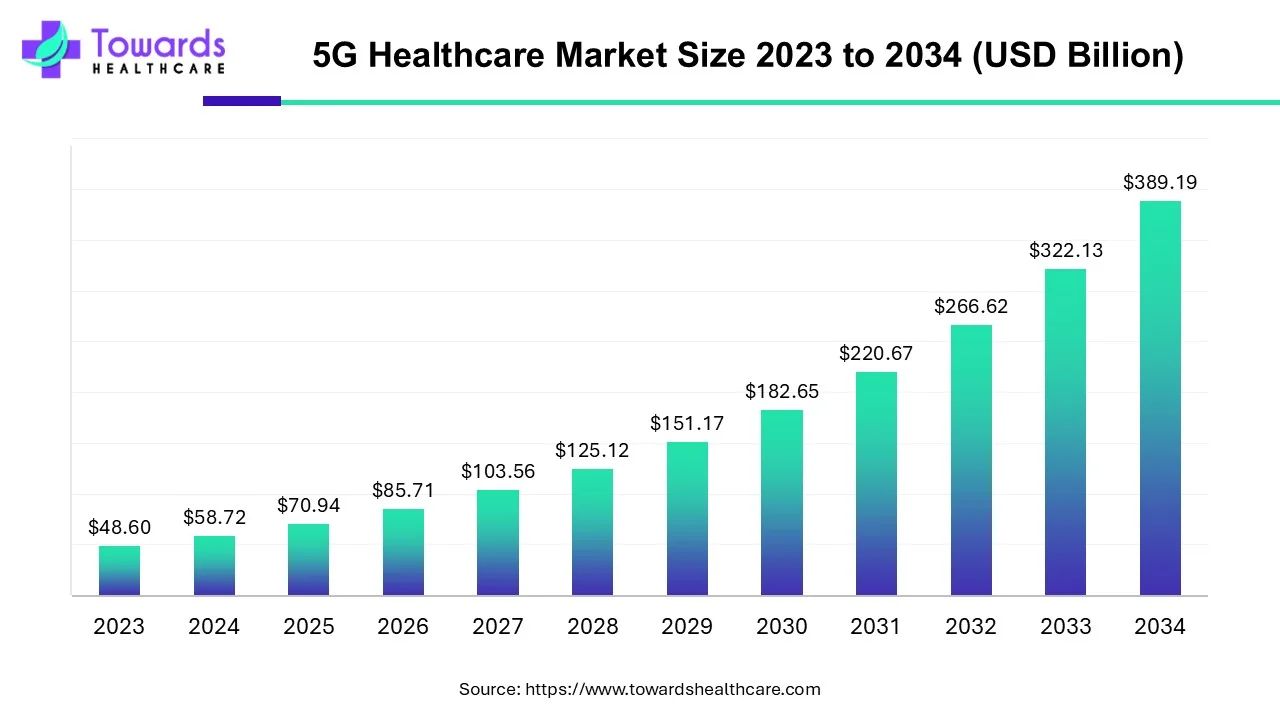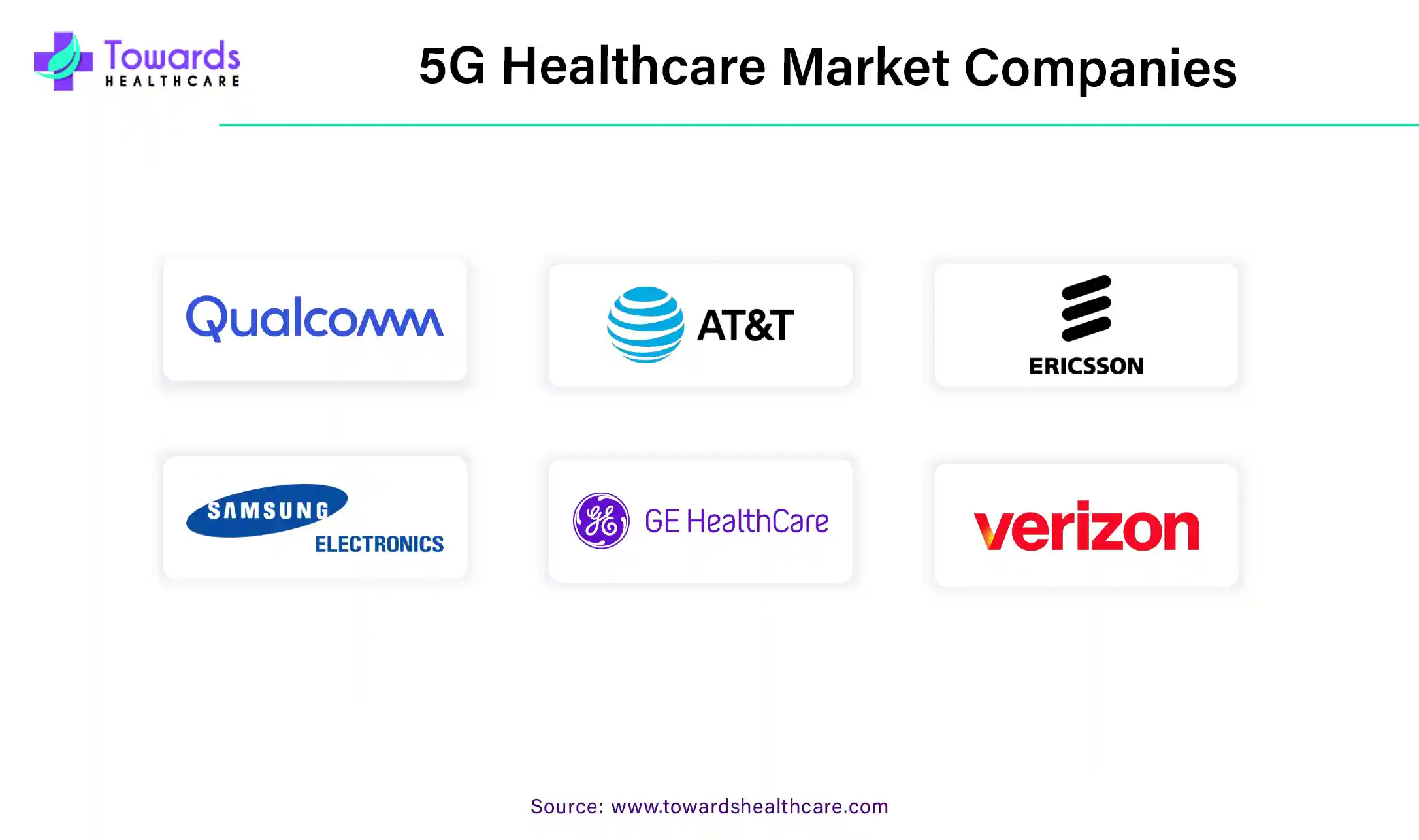March 2025


Principal Consultant

Reviewed By
The global 5G healthcare market size is predicted to expand from USD 70.94 billion in 2025 to USD 389.19 billion by 2034, growing at a CAGR of 20.82% during the forecast period from 2025 to 2034, as a result of the rising preference for patient-centred care and rising adoption of remote surgeries.

According to a health technology company GlobalMed study, 74% of millennials choose teleconsultations over in-person visits. In comparison, only 5% of remote medical appointments lead to the necessity for a face-to-face appointment.
5G is the fifth-generation cellular wireless technology network with its key focus on speed. Other key features of 5G technology include ultra-low latency, superfast connectivity, and widespread coverage. With massive connection power and high speed, 5G technology can transform the healthcare industry. Patient value (patient-relevant outputs divided by expenses per patient to attain the outcomes) has been steadily declining, contributing to rising healthcare prices.
In addition, there is increasing concern about inadequate healthcare system administration, incorrect utilization of medical resources, and unfavourable medical situations. For instance, remote patient monitoring and telehealth reduce delays in communication between patients and caregivers; telehealth and remote patient monitoring, for example, reduce delays in communication between the care provider and the patient; however, issues such as overloaded networks and slow connectivity pose a severe problem, particularly for healthcare providers who may interact with numerous patients each day. Seamless connectivity is a must while serving the healthcare industry to provide patient-centred and timely services.
5G's virtual characteristics define it as fast, enormous, and credible. Here are the important 5G metrics:
5G IoT is set to revolutionize various industries, but its impact will unfold in phases. Initially, we'll see a surge in enhanced mobile broadband (EMBB) applications. Shortly after, ultra-reliable, low-latency communication (URLLC) use cases will start to gain traction. However, it will take several more years for massive machine-type communication (MMTC) applications to become mainstream.
Businesses that stand to gain significantly from the rise of 5G include mobile operators, network providers, component and module suppliers, as well as companies in the machinery, industrial automation, and manufacturing sectors.
In the B2B sector, the immediate opportunities for 5G IoT lie within Industry 4.0—the digitization of manufacturing and production processes. Here, 5G offers significant performance enhancements for various applications.
By 2030, the Industry 4.0 segment is expected to account for approximately 22 million 5G IoT units, with most of these being used in manufacturing. In other B2B segments, such as smart cities, smart energy, and connected health, 5G IoT will be favored mainly for niche applications.
The healthcare service provider sector is transitioning from economic incentives to rewards based on how patients suffer instead of the number of visits. More than 85% of hospital-based settings and health systems propose spending heavily on remote patient monitoring technology to significantly contribute to value-based care. For example, a patient's vital data could be collected via a Bluetooth-equipped glucose meter or blood pressure monitor linked to a mobile app for secure data sharing with the care provider.
The transition to value-based care can potentially assist patients with chronic diseases to avoid hospitalization. 5G investments will enable telemedicine, big data analytics AI, IoMT and immersive technologies like extended reality, AR and VR to serve patients and providers in stunning new ways. Palo Alto Health Care System was developed as Virginia’s and the world’s one of the first 5-G-enabled hospitals. The healthcare industry is on the edge of breakthroughs that will improve care quality and create operational economies due to 5G-enabled smart devices and new 5G networks. Numerous major obstacles must be overcome to realize this objective. Fortunately, 5G can assist.
5G investments will enable telemedicine, IoMT, big data analytics, AI, and immersive technologies like AR, VR, and extended reality to serve patients and healthcare professionals in incredible new ways. The healthcare industry is on the edge of breakthroughs that will improve care quality and create operational economies due to 5G-enabled smart devices and new 5G networks.
In addition, the patient is at the forefront of the healthcare industry. It can also be empowered by advanced technologies such as 5G technology with a new approach towards patient-centred care. The rising preference for online consultations, remote-customized plans, and continuous health data collection through high-speed data transmission technology augments the 5G healthcare market growth.
With the rise in the adoption of advanced technology, the amount of data or information healthcare providers manage, collect and analyze has remarkably increased. Technology is transforming the way data is used in the healthcare industry. Technology advancements, the adoption of 5G, and different software and tools have been extremely beneficial in expanding big data, making it easier and less expensive to store, access, and use healthcare information.
Big data analytics in healthcare utilizes an individual or community’s health information to understand the patient community or organization. Online healthcare services are one of the most popular sources that use data transfer through healthcare networks. 5G is set to revolutionize big data analytics in healthcare, enabling faster and more efficient analysis, disruptive applications, and eventually enhancing patient care and results. By addressing the problems and wisely utilizing its potential, 5G can revolutionize healthcare and open the path to a healthier future for all.
Switching to 5G can reduce these challenges while providing healthcare providers with a more ready network that has the ability to adapt to new technology. Meanwhile, medical device manufacturers can continue improving their gadgets' accuracy, detail, and capabilities without the impediment of a data cap.
The rate at which medical devices for remote healthcare generate data increases as they progress. Telemedicine necessitates a network capable of supporting high-quality, real-time video and remote patient monitoring in real-time with streaming and data processing, which necessitates low-latency connectivity. More real-time data assists clinicians in making more accurate patient assessments, yet employing current-generation connection technologies can also slow down overall hospital efficiency. Larger files take longer to move across departments when using 4G or older networks, causing physicians to wait for file transfers to complete.
Switching to 5G can reduce these challenges while providing healthcare providers with a more ready network capable of adapting to new technology. Meanwhile, medical device manufacturers can continue improving their gadgets' accuracy, detail, and capabilities without the impediment of a data cap. Most of the world's leading companies have recently built 5G networks, with greater spectrum availability and operator investment expected to attract 3 billion subscribers by 2025.
5G can provide a network that allows medical device manufacturers to maintain their quest for advancement without worrying about data caps. This increases the pressure on material inventors to provide components that are reliable, long-lasting, and tiny enough to be minimally invasive for the patient.
With the latest developments in robotics, it is now possible to do surgery from a location other than the patient's. When a qualified surgeon cannot be present in the hospital at a specific time, remote surgery, also known as robotic telesurgery, is used. In this example, a remote surgeon can utilize tools to direct a robot, which then performs surgery on the patient. A screen or VR glasses assist the surgeon, who also receives audible feedback.
Although remote surgery is now viable in some cases, it must be improved by high transmission latency and overhead. Latency can cause complications such as unsynchronized information - visual, aural, and haptic feedback may be transmitted at separate rates. By reducing latency to 1-2 ms, 5G's dependable and ultra-fast connection might vastly expand the possibilities. A 5G link has already been used to execute several remote surgeries effectively, including spinal and endoscopic surgeries. 5G networks, like telesurgery, can potentially improve telemetered surgery.
In this situation, surgeons with specialized knowledge could guide those doing the procedure via video link. A similar technique could be used in 5G-enabled ambulances. A physician may use video to advise an ambulance crew on effectively caring for a patient. Such technologies have the potential to significantly improve the overall quality of treatment offered to patients.

Significant progress has been made in robotic surgery in the last few years. Urologic, gynecologic, thoracic, cardiothoracic, and gastrointestinal operations are best performed using robotic surgery. Furthermore, several large hospitals in the United States and worldwide have made robotic surgery a common practice. Robotic surgery has had a substantial impact on the surgical care of prostate cancer (PCa), with robotic-assisted radical prostatectomy (RARP) becoming a common procedure for localized PCa.
Telesurgery or remote surgery is a promising surgical innovation, but it takes on numerous hurdles. Zero-latency time and advancements in haptic feedback technologies are necessary for precise and well-done procedures. To tackle these challenges, technologies such as 5G networks, IoT, and haptic robotics should be integrated into telesurgery.
Healthcare is shifting away from the conventional offline model. During the COVID-19 epidemic, telemedicine and remote monitoring evolved into more widespread. 5G technology enables healthcare providers to monitor patients securely and accurately, providing real-time video consultations, remote vital sign monitoring, and even remote surgery. The 'tactile Internet,' which will allow doctors to conduct surgeries on patients remotely, will revolutionize the future of healthcare. This significant development will increase specialised care access, promptness, and affordability, improving global health equity.
Furthermore, 5G-enabled wearables will contribute to a bigger concept, the 'Internet of the body.' Video demonstrations of surgical methods and live operations broadcasting are now possible thanks to faster 5G networks. The Centers for Medicare and Medicaid Services (CMS) has made it easier for eligible providers to secure reimbursement to encourage healthcare organizations to engage in remote telehealth technologies. This can minimize the strain on healthcare facilities, especially in rural or isolated places while enhancing access to care and providing a competitive advantage.
By component, the hardware segment held a dominant presence in the market in 2024. Hardware systems incorporated with 5G networks include wearable devices, remote patient monitoring systems, and AR/VR tools. The growing demand for personalized diagnosis and treatment and the increasing adoption of wearable devices boost the segment’s growth. These tools provide customized services and help maintain privacy within the healthcare setting.
By component, the service segment is expected to grow at the fastest rate in the market during the forecast period. Services provide customized solutions to healthcare providers at affordable prices. The lack of trained professionals to operate hardware and software based on 5G technology potentially enhances the use of services, providing technical expertise. 5G technology services increase the speed, reliability, and capacity. Services also eliminate the need for favorable infrastructure in a healthcare setting.
By application, the remote patient monitoring segment led the global market in 2024. Remote patient monitoring allows patients to use mobile medical devices and technology, enabling physicians to track physical symptoms, chronic conditions, or post-hospitalization rehab. The growing need to increase the accessibility of healthcare services in rural areas governs the segment’s growth. 5G connectivity enables faster, more reliable connectivity and low-latency communications. The advent of sensors, wearables, and e-health devices drives the segment’s growth. Remote patient monitoring eliminates the need for patients to travel to primary care facilities.
By application, the connected medical devices segment is projected to expand rapidly in the market in the coming years. Integrating a 5G network in connected medical devices enables seamless communication anytime and anywhere. This leads to faster, more reliable communication between healthcare providers and patients. Some common examples of connected medical devices include wearable devices, implantable devices, health apps, diagnostic monitors, and therapeutic devices. This enables real-time monitoring of the patient’s vital signs, improving patient treatment outcomes and reducing healthcare costs.
By end-use, the healthcare payers segment is anticipated to grow with the highest CAGR in the market during the studied years. 5G technology has been found to significantly impact the insurance industry. It helps healthcare payers to enhance the speed of claims processing, personalized policies, and real-time data analytics. This ultimately leads to enhanced customer experiences and improved operational efficiency. The increasing healthcare spending and the availability of government and private reimbursement policies fuel the segment’s growth.
North America dominated the 5G healthcare market due to advanced technology, healthcare infrastructures, and supportive government regulations. In the United States, many federal authorities, including Prevention, the National Institutes of Health, the Federal Communications Commission, the Food and Drug Administration and the Centers for Disease Control, regularly review studies and update regulations relating to health and wireless.

Several government bodies across developed countries extensively support this field and have established some favourable regulations, expanding the the 5G healthcare market growth. For instance, the European Union's Scientific Committee on Emerging and Newly Identified Health Risks (SCENIHR), the World Health Organization (WHO), and the International Commission on Non-Ionizing Radiation Protection (ICNIRP) have all found that exposure to wireless connections and their use has no negative impact on human health if it is kept below the ICNIRP's recommended limits.
In addition, AT&T's latest private 5G network is helping to transform the way patients and researchers connect at USC's Lawrence J. Ellison Institute for Transformative Medicine. The on-site 5G network delivers lightning-fast connection for patient-centred cancer treatment, wellness, and research education. The Ellison Institute is one of the country's first medical institutes to use 5G to aid the progress of cancer research. In September 2023, Pixel Health collaborated with Ingram Micro and T-Mobile to create a holistic solution for Boston Children's IT needs, utilizing a 5G Hybrid Network from T-Mobile's Advanced Network Solutions (5G ANS) to encourage clinical innovation and boost patient care.
Asia-Pacific is anticipated to grow at the fastest rate in the market during the forecast period. The rising adoption of advanced technologies and increasing investments drive the market. Advancements in telecommunication networks in Asia-Pacific countries and the increasing affordability of 5G networks promote the market. China has surpassed 4.04 million 5G base stations as of August 2024. The increasing consumer acceptance of wearable devices and telemedicine services for personalized care governs the market growth. Favorable government policies to adopt 5G services in healthcare and increasing investments favor the market. It is estimated that 5G will contribute around INR 36.4 trillion to India’s economy between 2023 and 2040, representing over 0.6% of its GDP by 2040.
Ganesh Laxminarayanan, CEO of Airtel Enterprise Business, commented that a 5G network can be useful in telehealth, remote surgery, transferring large medical files, tracking patient movement, and wearable devices. He envisioned that a new connected healthcare ecosystem would take shape with 5G in healthcare and would align with the new 4P medicine – predictive, preventative, personalized, and participatory.

By Component
By Application
By End-User
By Region
March 2025
March 2025
March 2025
March 2025